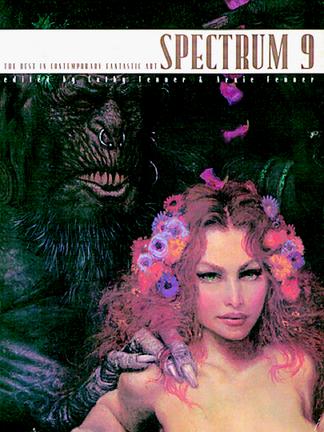In February 2002, artists working in advertising, book publishing and comic books, and for such clients as The New Yorker and Rolling Stone, descended on Kansas City in the hope that their work might grace the pages of the ninth installment of this modest-sized coffee table book. During the arcane process of judging the best work from 2001, the showroom was changed out five times.
Arnie Fenner’s introduction addresses facets of the 9-11 experience with aplomb. Then he dares the hopeful perspective that, ultimately, nothing changed. We go to work and raise our kids, and, for those whose lives revolve around creative endeavors, “Art goes on.” What follows are 173 pages packed with imagery to prove Arnie’s point.
In the advertising category, Douglas Smith’s poster for The Mystery of Edwin Drood is rendered in watercolor and scratchboard. The medium is crisp, vivid and seems three-dimensional, employed here for the arresting image of a skull-faced fellow in top hat and tails holding a stunned lady in a swoon, the startling scene lit from below on a stage.
Overall, I think the artwork in the book category is the most intriguing. (Precisely why that should be the case, I don’t know.) Shaun Tan’s dream-like oil painting, “Darkness Overcomes You,” depicts a city at sunset, adults and children going about their lives, none of their faces quite visible. The only startlingly prominent face is that of a gape-mouthed, building-high fish emerging, unnoticed, from between two skyscrapers just above the street to cast its shadow on the pavement.
There are a lot of fascinating sculptures in the 12-page dimensional category, such as Lawrence Northey’s plucky gold and silver robot, “L-roy,” cleverly constructed from metal and glass with ray gun in hand.
The editorial category is my second favorite. Rafal Olbinski’s contribution to Entertainment Weekly, titled “The Year that Was,” features a rosy-cheeked boy dressed as a harlequin in white, a tear falling from his eye. The background is a blue sky, his chest open with cupboard doors depicted as the two halves of an American flag, his hand holding a red rose over the area where the heart should be inside his dark interior, a crescent moon suspended in the background of his internal night.
There are more categories and 173 pages of images representing work rendered in various media by professionals in the world of imaginative art, including a high percentage of the archetypal, the dream-like and the Jungian. Along the way, of course, is the occasional buxom, fur-thonged damsel, and some wearing even less … not that there’s anything wrong with that!









